Perhaps the biggest packaging news of the year—which broke Tues., Sept. 18—is Amazon’s incentive program and requirement for certified Frustration-Free Packaging (FFP) for select products sold and fulfilled by Amazon. Initial public reaction from the industry has primarily been positive.
Packaging Digest also reached out to a half-dozen packaging pundits to get their expert opinions on Amazon’s new packaging requirements. They make a lot of good points and ask interesting questions.

Brian Wagner, co-founder and principal, PTIS LLC: “We have worked with clients to develop holistic ecommerce and omni-channel packaging strategies. This fast-growing channel is driving and will drive packaging, automation and supply chain innovation, to cut waste and improve margins for all across the entire value chain. We also provide consulting advice, design and opportunities for Amazon FFP and SIOC [Ships in Own Container].
“Some thoughts on the new incentive program:
• Consumers will love it and should help to centralize waste for collection, so that is good.
• Amazon’s timing seems a bit aggressive, so we assume it will be phased in.
• Directives like the Walmart Scorecard and item level RFID [radio frequency identification] set a bad precedence, and didn’t work. However, mandating concentrated liquid laundry detergent made a truly positive impact. Amazon’s directive is consumer and cost driven.
• This will likely be the “kickstart” that many companies needed to truly design packaging for the ecommerce channel. Many have been using the exact same package format they use in retail and simply let Amazon rebox the product.
• This could really have a dramatic change on package design—elimination of windows and cut outs, for example. Do you put the nice graphics on the inside of the box instead to delight the consumer upon opening?
• This could have a dramatic effect on Amazon’s shipping costs—no longer shipping a box in another box.
• There will be lots of pressure to get certified FFP based on the timing—labs will be busy!
• Timing could be tough—many packages have been designed for retail, but not the rigors of single-unit direct-to-consumer shipping. Impacts could be pretty large based on which categories are selected by Amazon.
• This is just the start. I can see this (Amazon’s ecommerce pack) becoming a standard package format in every company’s product portfolio as Amazon expands this to other categories. If you’re not impacted today, I’d take the time to start thinking about how you would achieve FFP certification and protect your product for direct-to-consumer shipping (which is likely for products and SKUs [stock-keeping units] over a certain size).
• Packages that are easier for consumers will generate positive reviews, and will ultimately lead to more package recycling.
• Be sure to use How2Recycle labeling to communicate to the consumer!”
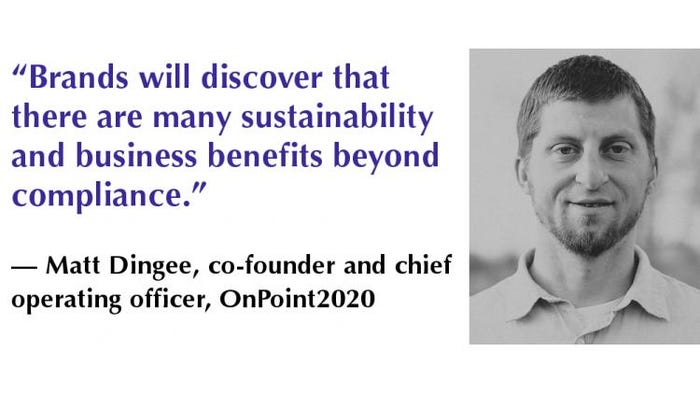
Matt Dingee, co-founder and chief operating officer, OnPoint2020: “The Amazon news is a big step and I think will be a pivotal moment for brands and packaging in ecommerce. Although it has flashbacks to Walmart, I think it will have a more powerful outcome for two reasons.
“First, the mindset will change for brands to truly meet FFP compliance. Brands that take this to heart will necessarily engage experts and packaging ideas from all over to meet the Amazon guidelines. During this process, brands will discover that there are many sustainability and business benefits beyond compliance. As a result, brand mindset toward packaging design for ecommerce (Amazon) will be elevated.
“Second, FFP is primarily of direct benefit to the consumer. So the outcome is not actually serving Amazon or some subjective metric, but the consumer directly. The brand now has an opportunity to improve packaging and product design for a customer ecommerce experience!”
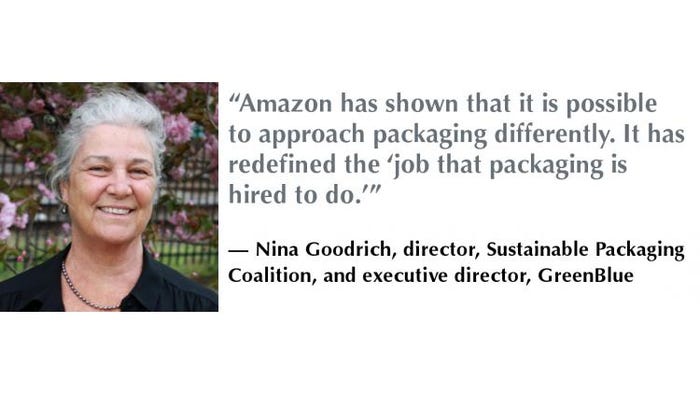
Nina Goodrich, director, Sustainable Packaging Coalition, and executive director, GreenBlue: “Amazon has shown that it is possible to approach packaging differently. I really applaud the focus on customer experience, reducing packaging waste and having the testing to insure the product is delivered to the consumer safely. It has redefined the ‘job that packaging is hired to do.’”
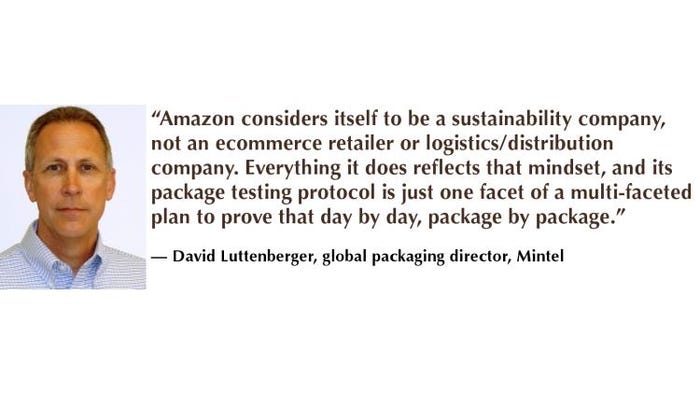
David Luttenberger, global packaging director, Mintel: “You drew a parallel between WalMart’s Scorecard and Amazon’s FFP certification program. I believe what Amazon is doing is very different and is being received by vendors in a totally positive light. Amazon is incentivizing CPG [consumer packaged goods] vendors and training them to create more environmentally responsible packaging, which in and of itself will save them money and create supply chain efficiencies. At the same time, it’s enabling them to retain proprietary branding while creating a more cost- and logistics-efficient system in which to sell and profitably compete.
“Mintel is now qualified as an APASS certified consultant, having gone through the training at Amazon’s Seattle headquarters. It’s eye-opening to see the ISTA6 testing protocols Amazon has developed and to witness real testing in person. Amazon tests packages and products to the worst-case scenario, the outcome of which is two-fold. First, it ensures that a consumer will receive products and packages that are undamaged and which reflect the equity of the brand. That is critical to a successful ecommerce experience for the consumer. Second, it will significantly reduce costs to Amazon for damaged and returned goods, which in turn will help it keep its overall costs of fulfillment and distribution as low as possible.
“Finally, it’s interesting—and totally believable once you experience it first-hand—but Amazon considers itself to be a sustainability company, not an ecommerce retailer or logistics/distribution company. Everything it does reflects that mindset, and its package testing protocol is just one facet of a multi-faceted plan to prove that day by day, package by package.”
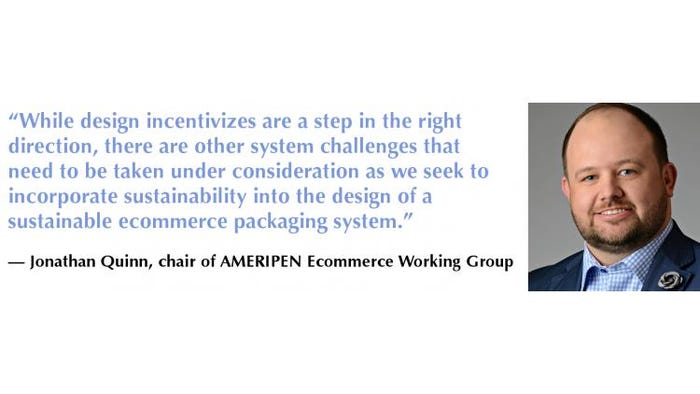
Jonathan Quinn, chair of AMERIPEN Ecommerce Working Group and market development manager, Nova Chemicals: “Ecommerce is a new distribution system. The distribution system for ecommerce packaging is much more dissipated, and less robust than what had been previously designed for retail distribution. With more touchpoints and less time in tertiary packaging, packaging may need to be reconceptualized to reflect these differences. Amazon’s packaging programs are reflective of the need to design for this new distribution channel.
“AMERIPEN recognizes the inherent value behind Amazon’s initiatives. Elements—like Ships in Own Container (SIOC), which focuses on consumer ease at opening, and an emphasis on recyclability—help initiate the process of systems thinking for packaging design.
“We caution, however, that while design incentivizes are a step in the right direction, there are other system challenges that need to be taken under consideration as we seek to incorporate sustainability into the design of a sustainable ecommerce packaging system. These approaches will require supply chain collaboration—not just amongst suppliers, converters and retailers but also with waste management services and governmental policy makers. Policies and programs related to access to recycling, material contamination, consumer shopping patterns and others all create impacts and unintended consequences. AMERIPEN believes that collaborative efforts to look across the system will help us anticipate and plan for the development of proactive solutions to address emerging ecommerce packaging challenges.
“Retail continues to struggle with many of the same challenges—refinements in sustainable packaging will continue—we certainly can’t expect easy sustainability solutions for ecommerce right away. But by having these conversations about sustainable packaging at the early onset of an emerging distribution channel, we can certainly hope to reduce the learning curve and develop expectations that sustainable packaging is a key tenet.”
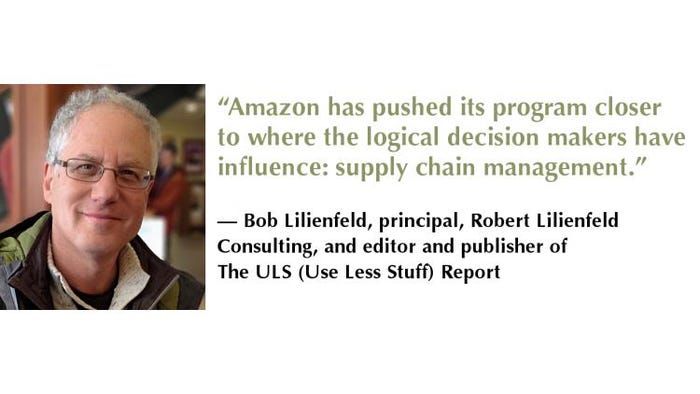
Bob Lilienfeld, principal, Robert Lilienfeld Consulting, and editor and publisher of The ULS (Use Less Stuff) Report: “This initiative removes the key obstacle faced by Walmart’s Scorecard program, which put the onus on their buyers to add a complex and sometimes conflicting task to their primary role of maximizing gross margin per square foot of shelf space. Amazon has pushed its program closer to where the logical decision makers have influence: supply chain management.
“It will, of course, lead to unintended consequences for some suppliers, such as removal of theft and tamper resistant blister-type overpacks for ecommerce, while continuing both their use and additional expense with brick-and-mortar retailers. There will, of course, be many hitches and unforeseen issues, and it will be interesting to see how these are handled and resolved.”
But what do you think?
It’s great to get this kind of assessment from sustainable and ecommerce packaging experts. But Packaging Digest wants to know what you think too. CLICK HERE to take our quick poll now. We’ll report on results in the next week or so.
********************************************************************************
Packaging solutions come to Minneapolis: As part of the region’s largest advanced design and manufacturing event, MinnPack 2018—and the five related shows taking place alongside it—brings 500+ suppliers, 5,000+ peers and 60+ hours of education together under one roof. Register for free today.
About the Author(s)
You May Also Like




